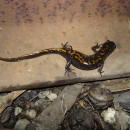About Us
This 367-acre coastal National Wildlife Refuge is located where the Salinas River empties into Monterey Bay. The refuge is roughly triangular in shape with the Pacific Ocean forming the western border, the Salinas River forming the northeast border, and the southern border running adjacent to privately owned parcels of land. Refuge lands include a range of terrestrial and aquatic habitats, including coastal dunes and beach, grasslands, a saline pond and salt marsh salt marsh
Salt marshes are found in tidal areas near the coast, where freshwater mixes with saltwater.
Learn more about salt marsh , and riparian riparian
Definition of riparian habitat or riparian areas.
Learn more about riparian habitats. Because of its location within the Pacific Flyway, the refuge is used by a variety of migratory birds during breeding, wintering, and migration periods.
The refuge also provides habitat for several threatened and endangered species. The threatened western snowy plover, just six inches tall, lays its eggs in simple scrapes on the sparsely vegetated foredunes of the refuge, as well as other beaches and salt pannes in California. And the endangered Smith's blue butterfly makes its home in the buckwheat patches found blooming throughout the backdunes.
Our Mission
The mission of the National Wildlife Refuge System is to administer a national network of lands and waters for the conservation, management and, where appropriate, restoration of the fish, wildlife and plant resources and their habitats within the United States for the benefit of present and future generations of Americans.
Other Facilities in this Complex
Salinas River National Wildlife Refuge is managed as part of the San Francisco Bay National Wildlife Refuge Complex. Other refuges in the San Francisco Bay National Wildlife Refuge Complex include: Ellicott Slough, Don Edwards San Francisco Bay, Farallon Islands, Marin Islands, San Pablo Bay, and Antioch Dunes National Wildlife Refuge.
The Refuge Complex headquarters is located at 1 Marshlands Rd. Fremont, CA. 94555.
A National Wildlife Refuge Complex is an administrative grouping of two or more refuges, wildlife management areas or other refuge conservation areas that are primarily managed from a central office location. Refuges are grouped into a complex structure because they occur in a similar ecological region, such as a watershed or specific habitat type, and have a related purpose and management needs. Typically, a project leader or complex manager oversees the general management of all refuges within the complex and refuge managers are responsible for operations at specific refuges. Supporting staff, composed of administrative, law enforcement, refuge manager, biological, fire, visitor services, and maintenance professionals, are centrally located and support all refuges within the complex.







